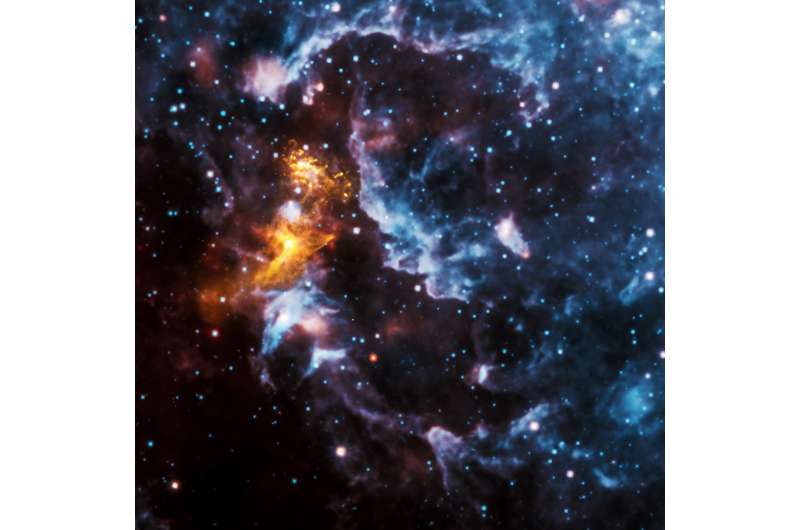August 2, 2016 feature
Physicists prepare to detect gravitational waves from neutron star collisions

(Phys.org)—Last February, scientists made the groundbreaking discovery of gravitational waves produced by two colliding black holes. Now researchers are expecting to detect similar gravitational wave signals in the near future from collisions involving neutron stars—for example, the merging of two neutron stars to form a black hole, or the merging of a neutron star and a black hole.
In a new study published in Physical Review Letters, Aleksi Kurkela at CERN and the University of Stavanger in Norway and Aleksi Vuorinen at the University of Helsinki in Finland have developed an improved method of analyzing the ultradense matter called "quark matter" that is thought to exist in the cores of neutron stars. Their method makes theoretical predictions regarding the properties of neutron star matter that researchers working with the future data will hopefully be able to test.
So far, the best quantitative description of quark matter works only at a temperature of absolute zero. Although this zero-temperature approximation is adequate for describing dormant neutron stars, neutron star collisions would have such drastically higher temperatures that thermal corrections are essential.
In the new study, Kurkela and Vuorinen have accounted for high-temperature effects and incorporated them into the equation of state that describes quark matter, generalizing the equation to relatively small but non-zero temperatures. This modified framework provides a much more accurate description of quark matter that is valid in the hot conditions present in neutron star mergers.
Quark matter
As their name implies, neutron stars are made mostly of neutrons, and like all known matter, neutrons are made of quarks. Usually quarks are tightly bound together in groups of three, but the enormous density and pressure in the core of a neutron star is thought to break the structure of the neutrons, so that the quarks separate and form quark matter. Whereas atoms are the basic constituents of the atomic matter that we're familiar with, the basic constituents of quark matter are quarks (along with gluons that hold the quarks together).
Currently, quark matter is not very well understood, mainly because it does not exist naturally on Earth. Researchers can produce quark-gluon plasma at high-energy particle colliders, such as the Large Hadron Collider (LHC), but it only exists for a fraction of a second before decaying because of the difficulty in maintaining the extreme conditions it requires.
Gravitational waves from neutron stars
An alternative to producing quark matter is to search for it in space. Using techniques similar to those that were recently used to detect gravitational waves from black hole collisions, researchers are currently searching for gravitational waves from neutron star collisions. Detecting the signal of such a collision would provide scientists with a wealth of new information on quark matter.
"The hope is that the gravitational wave signal from a merger of two neutron stars or a neutron star and a black hole would provide detailed information about the structure of neutron stars," Kurkela told Phys.org. "This in turn would enable researchers to infer the equation of state of the matter the stars are composed of, i.e., the thermodynamic properties of nuclear and quark matter."
If experimentally detecting quark matter is difficult, theoretically describing it is equally as challenging. This is because the description involves applying the strong force (which is mediated by the gluons) to the extremely high-energy matter of neutron stars.
"Our goal as particle/nuclear theorists is to predict the equation of state from first principles, i.e., starting from the basic properties of the theory of strong interactions, quantum chromodynamics (QCD)," Vuorinen said. "This is a long and very demanding challenge, but if we are successful, then one day when neutron star observations are accurate enough, our results can be used to interpret the observational data from neutron star mergers, and ultimately tell whether neutron stars have quark matter cores."
The results here also apply to the quark-gluon plasma produced in particle accelerators, which the scientists explain is somewhat different than the quark matter predicted to exist in neutron stars.
"The quark-gluon plasma that is produced in heavy ion collisions can be thought of as a hot but not very dense soup of quarks and gluons, while quark matter is a very dense and cold, essentially solid state, of matter," Kurkela said. "Our work in fact bridges the gap between these two systems, as our result is applicable at all temperatures, unlike any of the previous results."
In the future, the researchers plan to further refine their method to improve its predictions.
"Together with our collaborators both from Europe and the US, we are actively working towards improving the current state-of-the-art results for the zero-temperature equation of state of quark matter," Vuorinen said. "We hope to have the next orders of the so-called weak coupling expansion of the equation of state available still during this year, which will allow a refined prediction of the properties of cold quark matter."
More information: Aleksi Kurkela and Aleksi Vuorinen. "Cool Quark Matter." Physical Review Letters. DOI: 10.1103/PhysRevLett.117.042501
Journal information: Physical Review Letters
© 2016 Phys.org




















